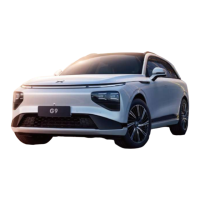• The brake pedal is pressed.
• Manually control the steering wheel.
• The driving speed exceeds 130km/h.
• The lane conditions are not met.
• The vehicle shifts to another gear.
• The seatbelt of the driver is released.
• A vehicle door is open.
• The camera is blocked or blind. Blindness
due to the obscure by dirt, water spots,
ice, and snow, or due to light illumination,
dimness, and others.
• The tire pressure monitoring system alarms.
• The wiper is at gear HI.
• There is a fault in the system and a repair is
needed.
• The road grade is not met.
• The system detects that the driver is losing
attention or tired.
• Dark (poor light) or poor visibility (due to
heavy rain, heavy snow, heavy fog, and
others).
LCC is not applicable in the situations below:
• There are sharp turnings on the road or
bad road conditions, for example, bumpy,
slippery icy, or waterlogged roads.
• There are fencing, road edge, zebra
crossing, and arrow at the junction of
slopping roads, uphill or downhill sections,
turning on the highway, or sharp turning
sections
• The lane is too wide or too narrow.
• The road where pedestrians or riders may
appear.
• When the hard light (for example the
headlamp light or the direct sunlight)
interferes with the camera's field of view.
• The camera’s field of view, or the lane lines
are blocked by the preceding vehicle.
• The camera’s field of view (blocked by water
mist, dust, or sticker) is blocked by the
windscreen.
• There are no lane lines, or the lane
lines are excessively worn or obscured,
$VVLVWHG'ULYLQJ
61
3
https://www.automotive-manuals.net

